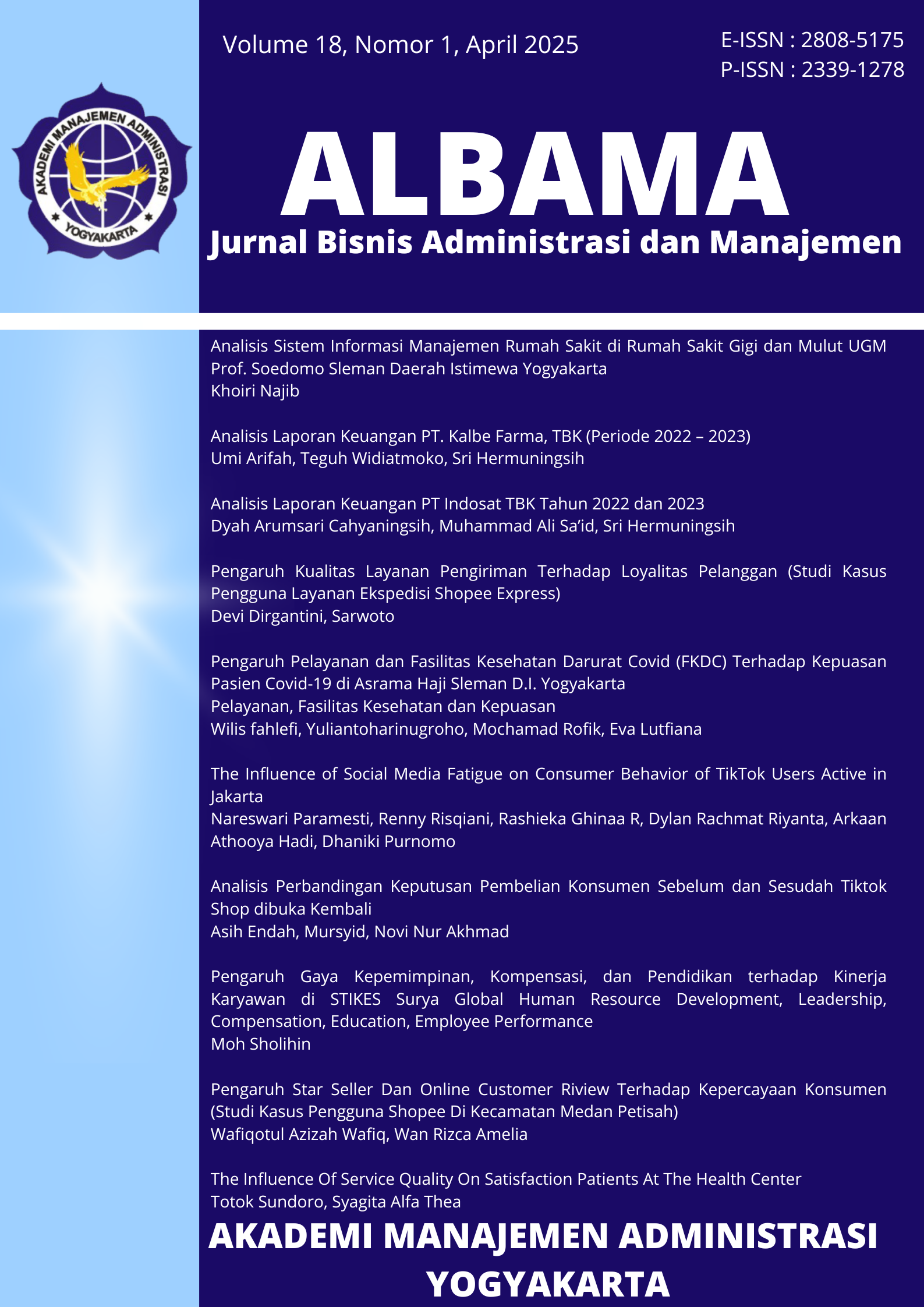The Influence of Social Media Fatigue on Consumer Behavior of TikTok Users Active in Jakarta
DOI:
https://doi.org/10.56606/albama.v18i1.253Keywords:
Branded Content Overload, Branded Content Irrelevance, Branded Ads Intrusiveness, Social Media Fatigue, TikTokAbstract
This study aims to analyze the influence of Branded Content Overload, Branded Content Irrelevance, and Branded Ads Intrusiveness on Social Media Fatigue, as well as its impact on Lurking Behavior among TikTok users in Jakarta. This research employs a quantitative method with a survey approach using questionnaires distributed to respondents. Data was collected from 250 active TikTok users in Jakarta. The results reveal that Branded Content Overload, Branded Content Irrelevance, and Branded Ads Intrusiveness positively affect Social Media Fatigue. Furthermore, Social Media Fatigue significantly drives passive user behavior, known as Lurking Behavior. Mediation analysis indicates that Social Media Fatigue mediates the relationship between independent variables and Lurking Behavior. These findings provide practical implications for marketers to regulate content frequency, relevance, and intrusiveness to avoid user fatigue and maintain engagement on social media platforms.
Downloads
References
Alghifari Yunus, M. F., Bahfiarti, T., & Farid, M. (2024). Pemanfaatan Media
Sosial Anak Petani Kakao di Kecamatan Wotu Kabupaten Luwu Timur.
Jurnal Sosial Dan Sains, 4(5), 367–380.
https://doi.org/10.59188/jurnalsosains.v4i5.1406
Ashley, C., & Tuten, T. (2014). Creative Strategies in Social Media Marketing:
An Exploratory Study of Branded Social Content and Consumer Engagement.
Psichology & Markerting, 32(1). https://doi.org/Marketing 32(1) DOI:
1002/mar.20761
Awaliyah, C., Dewi, D. A., & Furnamasari, Y. F. (2021). Media Sosial
Mempengaruhi Integrasi Bangsa. Jurnal Pendidikan Tambusai, 5(3), 7869.
https://jptam.org/index.php/jptam/article/view/2259
Bougie, R., & Sekaran, U. (2016). Research Methods For Business?: A Skill
Building Approach.
Buunk, A. P., & Gibbons, F. X. (2007). Social comparison: The end of a theory
and the emergence of a field. Organizational Behavior and Human Decision
Processes, 102(1), 3–21. https://doi.org/10.1016/j.obhdp.2006.09.007
Cho, C. H., & Cheon, H. J. (2004). Why do people avoid advertising on the
internet? Journal of Advertising, 33(4), 89–97.
https://doi.org/10.1080/00913367.2004.10639175
De Vries, L., Gensler, S., & Leeflang, P. S. H. (2012). Popularity of Brand Posts
on Brand Fan Pages: An Investigation of the Effects of Social Media
Marketing. Journal of Interactive Marketing, 26(2), 83–91.
https://doi.org/10.1016/j.intmar.2012.01.003
Dhir, A., Yossatorn, Y., Kaur, P., & Chen, S. (2018). Online social media fatigue
and psychological wellbeing—A study of compulsive use, fear of missing
out, fatigue, anxiety and depression. International Journal of Information
Management, 40(January), 141–152.
https://doi.org/10.1016/j.ijinfomgt.2018.01.012
Edwards, S. M., Li, H., & Lee, J. H. (2002). Forced exposure and psychological
reactance: Antecedents and consequences of the perceived intrusiveness of
pop-up ads. Journal of Advertising, 31(3), 83–95.
https://doi.org/10.1080/00913367.2002.10673678
Eppler, M. J., & Mengis, J. (2004). The concept of information overload: A
review of literature from organization science, accounting, marketing, MIS,
and related disciplines. Information Society, 20(5), 325–344.
https://doi.org/10.1080/01972240490507974
Febriani, S. R., & Desrani, A. (2021). Pemetaan Tren Belajar Agama Melalui
Media Sosial. Jurnal Perspektif, 14(2), 312–326.
https://doi.org/10.53746/perspektif.v14i2.49
Fox, J., & Moreland, J. J. (2015). The dark side of social networking sites: An
exploration of the relational and psychological stressors associated with
Facebook use and affordances. Computers in Human Behavior, 45, 168–176.
Grewal, D., Bart, Y., Spann, M., & Zubcsek, P. P. (2016). Mobile Advertising: A
Framework and Research Agenda. Journal of Interactive Marketing, 34, 3–14.
https://doi.org/10.1016/j.intmar.2016.03.003
Handayani, N. S., & Rahyuda, K. (2020). Website Quality Affects Online Impulse
Buying Behavior (OIBB): Moderating Effects of Sales Promotion and Digital
Wallet Use (A Study on Tokopedia E-Commerce). International Journal of
Economics and Management Studies, 7(12). https://doi.org/DOI:
14445/23939125/IJEMS-V7I12P103
John Sweller, Paul Ayres, S. K. (2011). Cognitive Load Theory. Springer Science
& Business Media.
Lee, A. R., Son, S. M., & Kim, K. K. (2016). Information and communication
technology overload and social networking service fatigue: A stress
perspective. Computers in Human Behavior, 55, 51–61.
https://doi.org/10.1016/j.chb.2015.08.011
Li, J., Guo, F., Qu, Q. X., & Hao, D. (2022). How Does Perceived Overload in
Mobile Social Media Influence Users’ Passive Usage Intentions? Considering
the Mediating Roles of Privacy Concerns and Social Media Fatigue.
International Journal of Human-Computer Interaction, 38(10), 983–992.
https://doi.org/10.1080/10447318.2021.1986318
Paas, F. P., Renkl, A. R., & Sweller, J. S. (2016). Cognitive Load Theory and
Instructional Design: Recent Developments. Educational Psychologist: A
Special Issue of Educational Psychologist: Volume 38, 38(April), 1–4.
https://doi.org/10.4324/9780203764770-1
Pang, H. (2021). How compulsive WeChat use and information overload affect
social media fatigue and well-being during the COVID-19 pandemic? A
stressor-strain-outcome perspective. Telematics and Informatics, 64(July),
https://doi.org/10.1016/j.tele.2021.101690
Putri, M. E., Zaelani, A. Q., Fasa, M. I., & Ronaldo, R. (2024). Potensi Dan
Tantangan Manajemen Pemasaran Syariah Dalam Industri Marketplace Halal
Di Indonesia. Analisis, 14(01), 73–91.
https://doi.org/10.37478/als.v14i01.3598
Su, H. Y., & Liu, X. Y. (2022). Algorithm Analysis of Clothing Classification
Based on Neural Network. Journal of Applied Data Sciences, 3(2), 82–88.
https://doi.org/10.47738/jads.v3i2.61
Sweller, J. (1988). Cognitive load during problem solving: Effects on learning.
Cognitive Science, 12(2), 257–285. https://doi.org/10.1016/0364-
(88)90023-7
Sweller, J. (2011). Cognitive Load Theory. In Psychology of Learning and
Motivation - Advances in Research and Theory (Vol. 55). Elsevier Inc.
https://doi.org/10.1016/B978-0-12-387691-1.00002-8
Utami, G. A., Nawawi, Z. M., Islam, U., & Sumatera, N. (2022). Media Sosial Dalam Peningkatan Jaringan Pasar. Journal Economy And Currency Study (JECS), 4(2), 93–98. https://pusdikrapublishing.com/index.php/jecs/article/view/752/649
Zerres, C. (2019). The Dark Side of Social Media. The Dark Side of Social
Media, 13(2), 175–200. https://doi.org/10.1016/c2017-0-04063-6
Zheng, H., & Ling, R. (2021). Drivers of social media fatigue: A systematic
review. Telematics and Informatics, 64(July), 101696.
https://doi.org/10.1016/j.tele.2021.101696
Zhu, Y. Q., & Chang, J. H. (2016). The key role of relevance in personalized
advertisement: Examining its impact on perceptions of privacy invasion, selfawareness, and continuous use intentions. Computers in Human Behavior, 65,
Downloads
Published
How to Cite
Issue
Section
License
Copyright (c) 2025 Nareswari Paramesti, Renny Risqiani, Rashieka Ghinaa R, Dylan Rachmat Riyanta, Arkaan Athooya Hadi, Dhaniki Purnomo

This work is licensed under a Creative Commons Attribution 4.0 International License.




.jpg)
